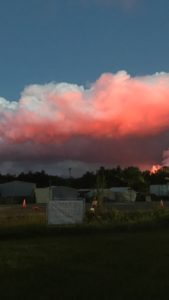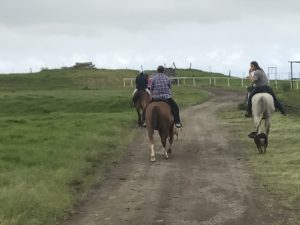 I travelled to the Big Island of Hawaii twice in the past few months, during the time its Kilauea volcano was erupting and CNN was live streaming the geyser of molten lava spewing up from the ground, when salacious headlines like Peril in Hawaii were exceedingly common. As you would imagine, these media outlets offered none of the important context as to what they were reporting.
I travelled to the Big Island of Hawaii twice in the past few months, during the time its Kilauea volcano was erupting and CNN was live streaming the geyser of molten lava spewing up from the ground, when salacious headlines like Peril in Hawaii were exceedingly common. As you would imagine, these media outlets offered none of the important context as to what they were reporting.
Consequently when I talked to friends or people on the street while at home in California, most of them were under the impression that the entire Big Island was engulfed in flames.
In reality, the lava flow from Kilauea came to cover about 9.6 square miles of land (much of which has been covered in lava for years as Kilauea has been constantly oozing lava) and the Big Island is 4,028 square miles.
That means .002 percent of the island was directly impacted by the lava flow although other parts of the island caught some fumes, prompting some tourists to wear surgical masks for no apparent reason.
Still, this would be akin to there being a forrest fire in Fargo and a foreigner watching their television coming to believe that the entire continental United States had been burned to the ground.
That’s not to say there wasn’t a legitimate crisis.
Along with my family, including my mom and dad who have lived on the Big Island for the past eighteen years, I visited the site of the eruption while it was at its most intense. That is to say we got as close to the eruption as we were legally able on land, which was the town of Puna.
It is estimated that 700 homes were destroyed by the Kilauea eruption, although the number is likely much higher because many homes in the path of the lava flow were ramshackle dwellings that were not permitted and therefor not on any kind of official list.
It was an odd feeling being thrilled with the awesome sight of the eruption while being surrounded by the fenced off FEMA campsites and walking past the hundreds of displaced residents who had nowhere to go and were living in their cars and trailers.
Yet, again, Puna and the lava flow are a small corner of the Big Island. The airports weren’t affected, nor were any of the island’s most popular tourist destinations: the town of Kailua-Kona, or the myriad of beaches, luxury hotels, and quaint little towns along the Kona Coast, Kohala Coast, or Hamakua Coast.
That is why I found my two trips to the Big Island during this time somewhat disturbing.
Because the airlines have been able to skirt anti-trust laws and have actively engaged in price fixing, it is often expensive to get a ticket from the mainland to the Big Island.
Flying from Los Angeles I have paid as much as eleven hundred dollars roundtrip. When I went during this period, once in late June and another time in mid July, I was able to get a ticket for just over three hundred dollars, which is almost unheard of.
I was further shocked when I boarded my first flight, direct from LAX to Kona International. Of the dozens of times I have travelled to the Big Island I cannot remember this flight not being at full capacity, especially during this time of year.
I found myself having my own row of seats for the first time, and not only my own row, my own exit row! The tickets were so cheap because the airlines had no customers. This would have to attributed directly to the volcano.
When I arrived I noticed the airport was much less bustling than usual, and the beaches were far less crowded.
My parents had put their house up for sale a few months prior, and were disappointed they were receiving little or no interest in the property.
They theorized that, especially since many potential home buyers in the area in which they live are people coming over from the mainland, that people were being scared away from the Big Island because of the volcano.
Their house is roughly 60 miles, an hour and a half drive, from the affected area. Furthermore, the Big Island is divided into nine Hazard Zones in relation to the lava. One means you’re in danger, nine means there is zero chance you would be near the path of a lava flow.
Their house is in zone nine.
Once I returned home all of the hysteria and widespread distortion of reality I encountered from the people I talked to in California really began to concern me.
They would ask me if my parents’ house was on fire, which would be akin to a Big Island resident asking them if their face had been recently eaten off by a hobo on bath salts based on what they’d seen on CNN or Fox News.
How was their perception so off?
Certainly the visual of a giant geyser of fiery liquid rock gushing out of the earth gets people’s attention.
But so does a mugshot of a scary looking Mexican gangbanger with tattoos on his face. All of a sudden illegal immigrants are killing white Americans left and right, even though in reality they commit less crime than your average American citizen. Latinos are 17 percent of the US population. If you ask a Trump supporter, they’re well over 80 percent.
Take a clip of an autistic kid sitting in the corner and bobbing his head up and down. It’s a disturbing image. You see it on Facebook, and now you’re an anti-vaxer even though there’s zero correlation. Your puny brain needs to find a bogeyman, be it another human being, or a needle.
You see a clip of a school shooting and now you’re training your four year old in tactical combat, even though the only real danger is that coal plant a mile from your house.
The mainstream media has figured out what works for ratings. Along with distorting our perception of reality and risk, these sensational images also distract us from the real threats to us, from laws which actually affect us.
I always knew it was true, but it was never so obvious as those two trips to the Big Island of Hawaii.
I hope people can learn to open their eyes.
Statistically speaking, everything you fear is bullshit.

